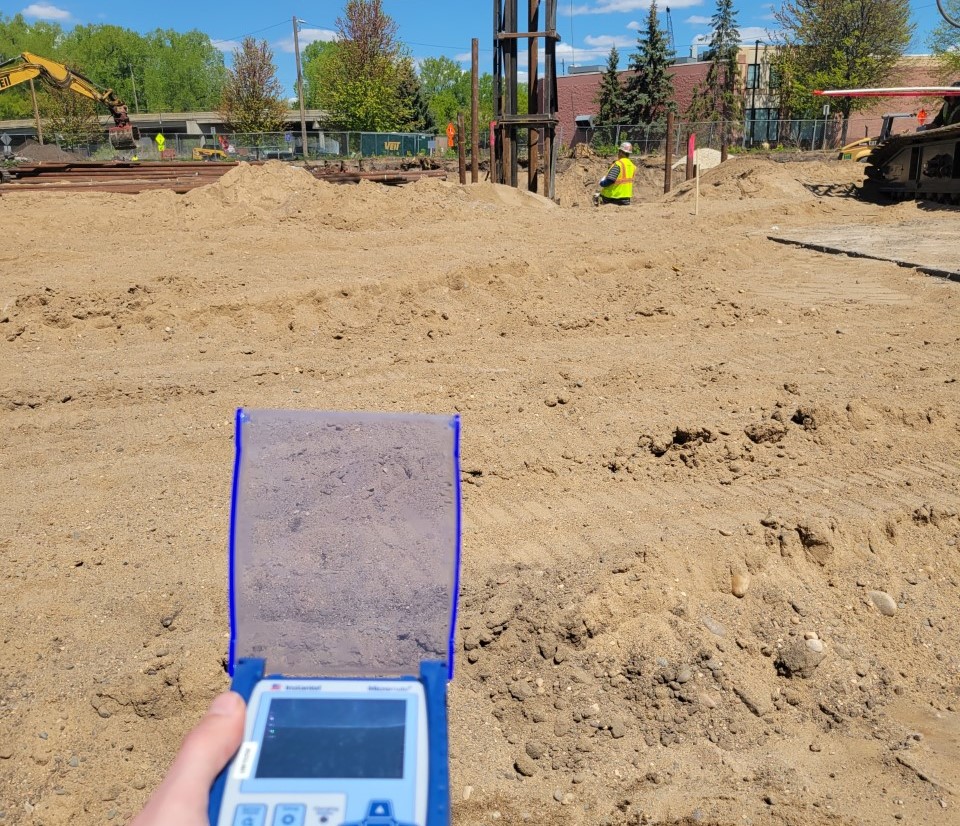Vibrations are present in our daily lives varying from household sources such as appliances and rambunctious toddlers; to construction sources like pile driving and vibratory compaction; and from natural sources such as earthquakes and wind. Each of these vibrations feel quite different to us, but is it possible to relate them to the thresholds we use for construction damage criteria?
First, let’s take a quick look at the most common vibration thresholds used in the United States, the United States Bureau of Mines RI-8507 and Office of Surface Mining Reclamation and Enforcement (RI-8507). While the thresholds in Figure 1. are not all-encompassing, they are the source material for many other threshold recommendations and provides a good reference graph to plot other vibration sources. RI-8507 is the source of the commonly used 0.5 in/sec threshold and includes the important frequency dependent thresholds that are often overlooked in specifications. Towards the end of this blog, we will take a look at how the above-mentioned sources fit on this threshold graph.

Residential Sources
Vibration sources in daily life include washers and dryers, air conditioners and furnaces, footfall, door slams, traffic, and dozens of other sources. While these sources vary in vibration character, they can be classified in a general range. Below are some approximate vibration levels for some of these sources:
Table 1. Peak Vibration Levels of Various Residential Vibration Sources (5 ft. from source)
| Source | Velocity (in/sec) | Frequency (Hz) |
| Washing Machine | 0.1 | 13-18 |
| Air Conditioner | 0.05 | 30-60 |
| Dryer | 0.05 | 0.1-1 |
| Door Slam | 0.5 | 70-100 |
| Traffic – 10 feet | 0.5 | 5-25 |
| Toddler Jumping (30 lb., 1st floor) | 1.0 | 70-100 |
| Footfall | 0.1 | 5-15 |
Natural Sources
Vibrations from sources in nature are less common but can be much more detrimental. The actual effect of vibrations from sources like wind and thunder are hard to measure as the effects of these are more often associated with pressure forces than vibrations. Earthquakes are the biggest example of structural vibrations, which often raises the question, “How do construction vibrations relate to the Richter scale?”. This answer is complicated by many factors, but for simplicity the Richter scale defines 3.0-3.9 as “felt by many people, no damage”, and 4.0-4.9 as “felt by all, minor breakage” so it could be said that construction vibrations are in the 3-5 Richter Scale range, typically.
Table 2. Estimated Vibration Levels of Various Natural Sources
| Source | Velocity (in/sec) | Frequency (Hz) |
| Earthquake (Richter 3) | 0.05-0.3 | 1-12 |
| Earthquake (Richter 4) | 0.3-1.0 | 1-12 |
| Earthquake (Richter 5) | 1.0-2.0 | 1-12 |
| Wind | NA | 0.001-1 |
| Thunder | 0.1 | 4-100 |
Construction Sources
Construction vibration sources have a lot of variability based on the equipment size, manufacturer, and soil type, but in most cases, they too operate within a moderately predictable range. Vibrations are usually classified as transient/impact or continuous/steady state. Think bang versus buzz.
Table 3. Estimated Peak Vibration Levels of Various Construction Sources at 20 feet.
| Source | Velocity (in/sec) | Frequency (Hz) |
| Demolition | 0.5 | 15-30 |
| Hammer Pile Driving | 1.0 | 20-40 |
| Rock Picking | 0.2 | 60-100 |
| Vibratory Compaction | 0.2 | 25-45 |
| Vibratory Pile Driving | 0.4 | 20-45 |
| Aggregate Piers | 0.4 | 30-60 |
While this information may be difficult to conceptualize, it makes a bit more sense when plotted against the RI-8507 damage thresholds. Figure 2. contains the above-mentioned vibration levels plotted against the vibration thresholds and human perception indices.
Figure 2. Estimated vibration levels from common vibration sources compared to RI-8507 thresholds and human perception.*
What we learn from this graph is that most construction vibrations at distances greater than 20 feet are on par with daily vibrations experienced in the home. While damage is possible, it should not be considered the norm. Construction vibrations are often unpleasant for building occupants and are especially unpleasant as they may happen much more frequently than high level vibrations in the home (door slams, kids jumping, etc.). Monitoring these vibration levels remains an important risk reduction strategy, even at low levels, as the perception of vibrations is often associated with damage. Establishing a baseline condition of the adjacent properties and having this survey performed by trained engineers and scientists is also critical to the process as this allows for accurate designation of vibration thresholds on a case-by-case basis. At Braun Intertec, our dedicated vibration monitoring team looks at every structure we survey as unique to provide the most accurate vibration thresholds possible.
To learn more about how different vibration types affect structures, check out our upcoming webinar, Decoding Vibration Thresholds: When Do Buildings Crack?, that will be broadcasted live on September 23rd with project engineers Ren Keyport, PE, and Cody Bain, PE.
*Disclaimer: The vibration levels presented here are more anecdotal than scientific and should be treated as such. The vibration thresholds provided by RI-8507 do not account for differences in transient and continuous vibrations, for the potential for soil consolidation, or for buildings in compromised conditions.


